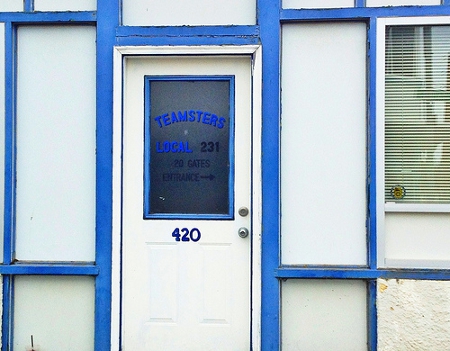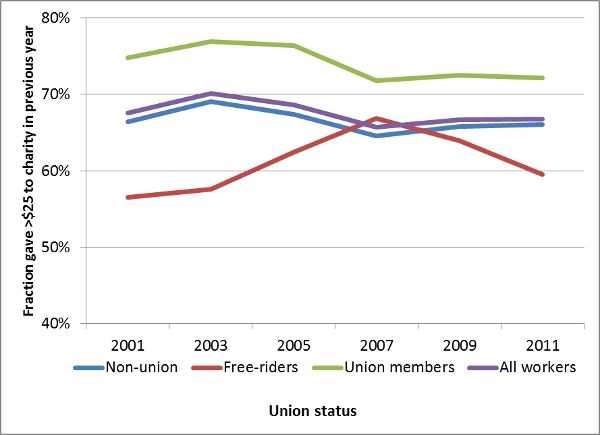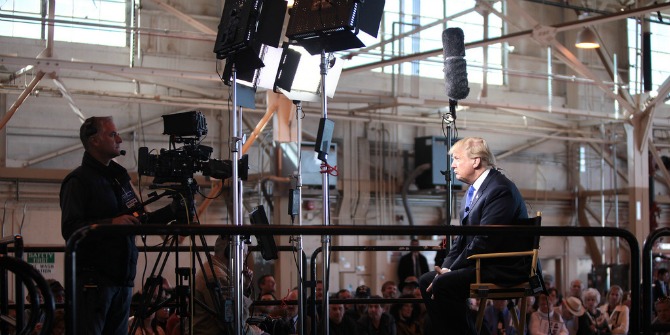
 While union membership has benefits to workers themselves, could these benefits have spill over effects that are also a boon to society? Jonathan Booth and Mark Williams look at the effects that union membership has on charitable giving, and find that being a union member makes people 5 percent more likely to give to charity, and also to give 30 percent more than non-union members. These findings, they argue, may have important implications for society in a time of declining union membership.
While union membership has benefits to workers themselves, could these benefits have spill over effects that are also a boon to society? Jonathan Booth and Mark Williams look at the effects that union membership has on charitable giving, and find that being a union member makes people 5 percent more likely to give to charity, and also to give 30 percent more than non-union members. These findings, they argue, may have important implications for society in a time of declining union membership.
American households give away comparatively huge sums of their income to charity. Around two-thirds make regular donations, giving away on average $2,000 annually, or about 3 percent of their average household income. At the aggregate, giving in the United States equates to three times the GDP of Sweden, Norway, and Denmark combined. Social scientists researching philanthropy have addressed two main sets of questions – who gives what, and how can we make people give more?
In one influential account on the subject regarding the first question, Arthur Brooks (2006) in his book Who Really Cares speaks of the “charitable divide” and the “two Americas.” His main finding – examining many social surveys – is that it is (perhaps surprisingly) liberal and nonreligious people who tend to give less to charitable causes, whilst it is the religious and conservative people that tend to be more charitable.

We had a hunch that labor unions’ role in charitable giving had been overlooked – so we set out to research it. We hypothesized that union members are more likely to give and give more because unions provide a voice at work and wage premiums, motivate them to act and think collectively, and encourage community behavior. Therefore, perhaps some sort of social exchange, social learning, or social information processing mechanisms are occurring where members feel obligated to give back, desire to emulate behavior given role models in their environment, or perhaps are retrieving information from their environment that inform their behavior.
Recent estimates of U.S. union membership are a little more than 11 percent of employees (14.4 million employees). And, workers who are protected by collective bargaining agreements but are not members comprise 1.3 percent of employees (1.6 million employees). So our first question is: do those covered by a union (i.e., employees who are dues paying members and/or are covered by a collective bargaining agreement) give more than those that aren’t?
Figure 1 – Union status and trends in charitable giving, 2001-2011

Figure 2 – Mean amount given to charity for those that gave by union status ($s in previous year)

In answering this question, we make a distinction between those who are members of the union at their workplace, and those that receive the benefits of a union and its collective bargaining contract but they themselves are not members (often referred to in the literature as “free-riders”). As Figure 1 shows, union members are more likely to give. Free-riders and non-union workers give at similar rates. However, in terms of the average amount given, as shown in Figure 2, there is not much evidence of significant differences among the three groups.
Because unionized workers differ from other workers in a variety of ways – we need to adjust for these factors to get at the “union effect.” Certain groups are overrepresented in unions relative to the overall labor force; public sector, men, black, and older workers are all more likely to be union members. Moreover, union members often receive a wage premium, given their skill level and occupation relative to non-union workers. Once we adjust for these factors, we find that union members are still more likely to give but also to give more.
But this could be because controlling for things like job and demographic characteristics are only proxies for the underlying attributes that actually influence the decision of whether to give and how much income to give away.
Perhaps the same or similar underlying reasons that make people give to charity also make certain people more likely to join a union. In other words, there are many factors which we cannot readily measure and so cannot adjust for to see if it is being a union member that actually makes one more likely to give to charity and give more or whether it is these kind of unobserved factors that are numerous and hard to measure that are driving the apparent association.
Luckily, we have data that follows the same households over time – the long-running socio-economic study that has been charting American families since 1968 called the Panel Study for Income Dynamics (PSID). We use the biennial Center for Philanthropy Panel Study supplement (COPPS) – which has collected data on charitable giving for the same families from 2001-2011.
This means we can track individuals over a fairly long period of time and separate out whether those that join a union give more after joining one (the within-person union effect) from the effect of time spent as a union member (the between-person union effect). Compared to non-union workers, we find that joining a union increases one’s probability of giving by about 5 percent. In addition, the amount given to charity is boosted by a little over 30 percent, compared to non-union workers. Moreover, the more often a respondent is observed being a union member, the more likely they are observed to give and to give more relative to those who have limited or no union membership tenure.
Free-riding, however, reduces one’s probability of giving by approximately 6 percent; while the amount given by free-riders is also reduced by 25 percent relative to non-union workers. The more time spent as a free-rider appears to only influence the choice of giving – reducing the probability by approximately 2 percent. This suggests unions do not induce all people whom they come into contact with to give to charity, particularly those who choose not to join and pay dues yet reap benefits from being covered by the collective bargaining agreement.
Our results appear robust to alternative specifications as well, for example, if we include past giving into our models – or if we restrict our sample to those who were never a union member prior to 2001. More importantly, we see that the positive effects of union membership appear in both right-to-work states (i.e., state law enforcing that union membership is an employee choice, and employees are not required to join the union but can reap benefits from the collective bargaining agreement) and non-right-to-work states (i.e., union membership generally is compulsory if working under a union contract in the workplace).
Taken together, our findings suggest that as well as safeguarding worker interests, unions seem to have a spill over effect with respect to charitable giving, and union members appear to inform their giving behavior from what they are learning from the unionized work environment. Compared to non-union members, actual dues paying, union members choose to give and give more of their income to charitable causes. However, the free-riders who do not pay dues yet benefit from the collective bargaining agreement appear less inclined to give. Union membership has a potentially significant role to play in bridging the “charitable divide” in the “two Americas.” However, if unions have an influence on charitable giving, and, from our data, it is apparent they do, one must question what are the societal implications for charitable giving and the benefits to the community as union density is declining.
Earlier we mentioned that Arthur Brooks suggested that religious conservatives give more. Interestingly, according to the Economic Values Survey, 13 percent of Democrats are religious conservatives; while more than a majority of Republicans are religious conservative (56 percent). Recently, in states that have had a long union tradition, Republican lawmakers have either introduced or passed laws that limit union power and perhaps contribute to union decline. For example, in 2011, a Republican controlled Wisconsin state legislature passed legislation that limited public sector workers’ bargaining power, while making union dues voluntary, requiring recertification elections each year, and raising most public sector workers’ contributions to health insurance and pension. In 2012, Michigan Republican lawmakers acquired enough votes to pass Right to Work legislation, and, in 2013, Ohio Republican politicians are threatening their own Right to Work legislation.
Given the unions’ influence on the decision to give and the amount given, perhaps employers, their representatives, and/or governments engaging in efforts to discourage unions and union organizing may not be the right direction to go – only time will tell the societal woes that potentially could arise as consequence of union decline and anti-union legislation. However, union decline cannot be totally attributed to business, politics, and legislation – historically public approval of unions has dropped perhaps providing some explanation for the dip in unionization. Nonetheless, maybe, everyone should have a thorough reflection instead of a knee jerk reaction and consider what might happen or what benefits might accrue to the general population if union membership was more encouraged. Given our findings, those who have labeled unions as greedy may want to reconsider.
Please read our comments policy before commenting.
Note: This article gives the views of the authors, and not the position of USApp– American Politics and Policy, nor of the London School of Economics.
Shortened URL for this post: http://bit.ly/17x3T3Q
_________________________________
 Jonathan Booth – LSE Department of Management
Jonathan Booth – LSE Department of Management
Jonathan Booth is a Lecturer in Employment Relations and Organisational Behaviour at the LSE’s Department of Management. His research interests include workplace aggression and victimization, appraisal and coping processes in the workplace, union membership and participation, dirty work, and prosocial behaviors (e.g., forgiveness and employee volunteering and giving).
 Mark Williams – University of Surrey
Mark Williams – University of Surrey
Mark Williams is a Lecturer in HRM and Employment Relations at the University of Surrey. Prior to this, he was a Fellow in the Employment Relations and Organisational Behaviour Group at the London School of Economics. His recent research has focused on the impact of profit-sharing and employee share-ownership on workplace performance across Europe; the changing structure of pay in Britain; the impact of workplace practices on subjective well-being in Britain.






